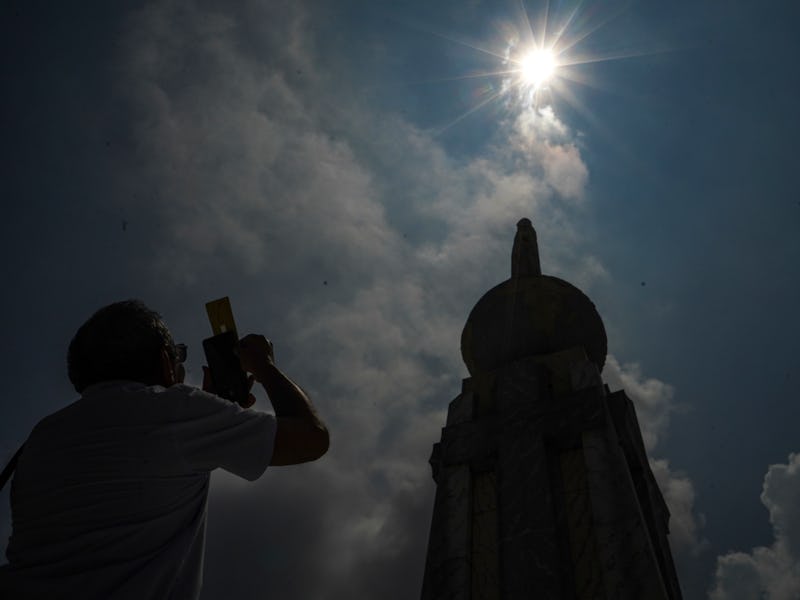This Easy, Free App Helps Take Beautiful Pictures of the Eclipse From Your Phone
SolarSnap is a quality, bare-bones camera app for taking pictures of the Sun.

University of Colorado Boulder astronomer Doug Duncan spent the months of the Covid-19 pandemic lockdown working on an app that is about to become incredibly popular.
“I take people to see eclipses,” says Duncan, “and in the last few, I noticed a lot of people trying to take a picture with their phone, but usually failing. One reason is that it's kind of hard to hold your phone, hold a pair of eclipse glasses in front of your phone with your other hand, and with your third hand, control the camera.” To solve that problem, he put together a solar filter designed for phone cameras.
The other problem was trickier and took Duncan and a software developer most of 2020 to solve.
“Phones are really, really good for faces. They can find faces and adjust everything. They're not so good for a round yellow thing in the middle of a blue sky. A picture of the Sun almost only has two values: black, and very bright. There’s none of the in-between tones,” says Duncan. “We made an app that gives you very easy control over your phone, and it's optimized for good pictures of the sun.”
Duncan emerged from lockdown with SolarSnap, a bare-bones camera app for taking pictures of the Sun. It has three sliders: one for zoom, one for focus, and one for exposure time. Most phones’ camera apps handle the latter two options automatically, but they’re programmed to find the right settings for a good selfie, not a clear picture of the partially hidden Sun. By handling the focus and exposure settings manually, users can make their phones’ cameras do something their software wasn’t really designed to do.
How to use the Solar Snap kit
The first part of the SolarSnap kit is an eclipse-glasses monocle for your phone. Users put a velcro disk onto the back of their smartphones and then use that to attach the SolarSnap filter. Your faithful correspondent used the filter during the annular eclipse in October 2023; it worked well, and while it’s flimsier than the kind of solar filter you could buy at a camera store, it’s also durable enough to be re-used in April. If the weather on eclipse day is windy, a little tape may help hold the filter in place.
In the app, there are three sliders for zoom, exposure, and focus. Duncan recommends practicing, without the filter, on indoor objects for a few minutes before the eclipse.
SolarSnap is a bare-bones camera app for taking pictures of the Sun. It has three sliders: one for zoom, one for focus, and one for exposure time.
The SolarSnap kit, designed by Duncan and manufactured by American Paper Optics, comes with two camera filters, two sets of eclipse glasses, and instructions for downloading the SolarSnap app; the app itself is free and will work without the filter, but you shouldn’t point your phone’s camera at the Sun without some kind of solar filter, unless you’re about to replace your phone anyway because pointing directly at the Sun will fry your optics.
What to do before totality or during a partial eclipse
Before the eclipse, Duncan recommends practicing with the app to get a feel for the controls; try indoor objects first, then move outdoors (if you’re not pointing at the Sun, leave the filter off, or you won’t be able to see anything).
To photograph the Sun, make sure you put the solar filter over your camera lens. Hold your phone in landscape mode and use it to shade your eyes (you should have your eclipse glasses off for this, or you won’t be able to see your phone screen at all) as you aim at the Sun.
First, use the zoom slider to decide how large you want the Sun in your picture. If the Sun looks weirdly bright or dim on your screen, move the exposure slider until it looks right. Then, move the focus slider until the edges of the Sun look sharp and clear; when you have the focus where you want it, push the lock button next to the slider.
What to do during totality
If you’re using the SolarSnap app, you can press the “Totality” button, and the app will automatically take several photos every few seconds during the total eclipse, so you can concentrate on watching. Duncan recommends using a tripod for this part, but you can also experiment with propping your phone up so it’s stable, secure, and pointed at the Sun. During totality – and only during totality – you can remove the camera filter (otherwise you won’t be able to see anything), but make sure you put it back on before totality ends.